Applicability of the Meniscus-Removal Method for Q-Band Liquid Characterization in Semi-Open Waveguide Cell †
Abstract
1. Introduction
2. Theory
2.1. Meniscus-Removal Method
2.2. Phase Ambiguity
- continuous phase while counting the logarithm;
- the proper n for the lowest frequency of measurement .
3. Design of the Rectangular Waveguide Fixture
4. Experimental Results
5. Discussion and Conclusions
Author Contributions
Funding
Institutional Review Board Statement
Informed Consent Statement
Data Availability Statement
Acknowledgments
Conflicts of Interest
References
- Kaatze, U. Techniques for measuring the microwave dielectric properties of materials. Metrologia 2010, 47, S91–S113. [Google Scholar] [CrossRef]
- Pakhomov, A.G.; Murphy, M.R. Low-intensity millimeter waves as a novel therapeutic modality. IEEE Trans. Plasma Sci. 2000, 28, 34–40. [Google Scholar] [CrossRef]
- Bois, K.; Handjojo, L.; Benally, A.; Mubarak, K.; Zoughi, R. Dielectric plug-loaded two-port transmission line measurement technique for dielectric property characterization of granular and liquid materials. IEEE Trans. Instrum. Meas. 1999, 48, 1141–1148. [Google Scholar] [CrossRef]
- Ogunlade, O.; Pollard, R.; Hunter, I. A new method of obtaining the permittivity of liquids using in-waveguide technique. IEEE Microw. Wirel. Compon. Lett. 2006, 16, 363–365. [Google Scholar] [CrossRef]
- Hasar, U.C. A calibration-independent method for accurate complex permittivity determination of liquid materials. Rev. Sci. Instrum. 2008, 79, 086114. [Google Scholar] [CrossRef]
- Hasar, U.C.; Cansiz, A. Simultaneous complex permittivity and thickness evaluation of liquid materials from scattering parameter measurements. Microw. Opt. Technol. Lett. 2010, 52, 75–78. [Google Scholar] [CrossRef]
- Guoxin, C. Calibration-independent measurement of complex permittivity of liquids using a coaxial transmission line. Rev. Sci. Instrum. 2015, 86, 014704. [Google Scholar] [CrossRef]
- Somlo, P. A convenient self-checking method for the automated microwave measurement of mu and epsilon. IEEE Trans. Instrum. Meas. 1993, 42, 213–216. [Google Scholar] [CrossRef]
- Hasar, U.C.; Kaya, Y.; Barroso, J.J.; Ertugrul, M. Determination of Reference-Plane Invariant, Thickness-Independent, and Broadband Constitutive Parameters of Thin Materials. IEEE Trans. Microw. Theory Tech. 2015, 63, 2313–2321. [Google Scholar] [CrossRef]
- Kalisiak, M.; Wiatr, W. Complete Meniscus Removal Method for Broadband Liquid Characterization in a Semi-Open Coaxial Test Cell. Sensors 2019, 19, 2092. [Google Scholar] [CrossRef]
- Weir, W. Automatic measurement of complex dielectric constant and permeability at microwave frequencies. Proc. IEEE 1974, 62, 33–36. [Google Scholar] [CrossRef]
- Baker-Jarvis, J. Transmission/Reflection and Short-Circuit Line Permittivity Measurements; NIST Technical Report; NIST: Boulder, CO, USA, 1990.
- Ball, J.; Horsfield, B. Resolving ambiguity in broadband waveguide permittivity measurements on moist materials. IEEE Trans. Instrum. Meas. 1998, 47, 390–392. [Google Scholar] [CrossRef]
- Ghodgaonkar, D.K.; Varadan, V.V.; Varadan, V.K. A Free-Space Method for Measurement of Dielectric Constants and Loss Tangents at Microwave Frequencies. IEEE Trans. Instrum. Meas. 1989, 38, 789–793. [Google Scholar] [CrossRef]
- Ghodgaonkar, D.; Varadan, V.; Varadan, V. Free-space measurement of complex permittivity and complex permeability of magnetic materials at microwave frequencies. IEEE Trans. Instrum. Meas. 1990, 39, 387–394. [Google Scholar] [CrossRef]
- Chen, L.; Ong, C.; Neo, C.; Varadan, V.; Varadan, V. Microwave Electronics: Measurement and Materials Characterization; Wiley: Hoboken, NJ, USA, 2004. [Google Scholar] [CrossRef]
- Baker-Jarvis, J.; Janezic, M.D.; Riddle, B.F.; Johhnk, R.T.; Kabos, P.; Holloway, C.L.; Geyer, R.G.; Grosvenor, C.A. Measuring the Permittivity and Permeability of Lossy Materials: Solids, Liquids, Metals, Building Materials, and Negative-Index Materials. arXiv 2005, arXiv:1011.1669v3. [Google Scholar]
- Varadan, V.V.; Ro, R. Unique Retrieval of Complex Permittivity and Permeability of Dispersive Materials From Reflection and Transmitted Fields by Enforcing Causality. IEEE Trans. Microw. Theory Tech. 2007, 55, 2224–2230. [Google Scholar] [CrossRef]
- Stenarson, J.; Yhland, K. A Reformulation and Stability Study of TRL and LRM Using S-Parameters. IEEE Trans. Microw. Theory Tech. 2009, 57, 2800–2807. [Google Scholar] [CrossRef]
- Hasar, U.; Westgate, C. A Broadband and Stable Method for Unique Complex Permittivity Determination of Low-Loss Materials. IEEE Trans. Microw. Theory Tech. 2009, 57, 471–477. [Google Scholar] [CrossRef]
- Luukkonen, O.; Maslovski, S.I.; Tretyakov, S.A. A Stepwise Nicolson–Ross–Weir-Based Material Parameter Extraction Method. IEEE Antennas Wirel. Propag. Lett. 2011, 10, 1295–1298. [Google Scholar] [CrossRef]
- Vicente, A.N.; Dip, G.M.; Junqueira, C. The step by step development of NRW method. In Proceedings of the 2011 SBMO/IEEE MTT-S International Microwave and Optoelectronics Conference (IMOC 2011), Natal, Brazil, 29 October–1 November 2011; pp. 738–742. [Google Scholar] [CrossRef]
- Fuh, K.F. Formulation for Propagation Factor Extractions in Thru-Reflect-Line/Line-Reflect-Line Calibrations and Related Applications. IEEE Trans. Microw. Theory Tech. 2016, 64, 1594–1606. [Google Scholar] [CrossRef]
- Costa, F.; Borgese, M.; Degiorgi, M.; Monorchio, A. Electromagnetic Characterisation of Materials by Using Transmission/Reflection (T/R) Devices. Electronics 2017, 6, 95. [Google Scholar] [CrossRef]
- Hasar, U.C.; Kaya, Y.; Ozturk, G.; Ertugrul, M. Propagation constant measurements of reflection-asymmetric and nonreciprocal microwave networks from S-parameters without using a reflective standard. Measurement 2020, 165, 108126. [Google Scholar] [CrossRef]
- Kalisiak, M.; Wiatr, W.; Papis, R. Design of a Waveguide Test Cell for Q Band Liquid Permittivity Measurements. In Proceedings of the 2022 24th International Microwave and Radar Conference (MIKON), Gdansk, Poland, 12–14 September 2022; pp. 1–4. [Google Scholar] [CrossRef]
- von Hippel, A.R.; Morgan, S.O. Dielectrics and Waves, 3rd ed.; Artech House: Boston, MA, USA, 1955. [Google Scholar]
- Pozar, D.M. Microwave Engineering, 4th ed.; Wiley: Hoboken, NJ, USA, 2012. [Google Scholar]
- Nicolson, A.M.; Ross, G.F. Measurement of the Intrinsic Properties of Materials by Time-Domain Techniques. IEEE Trans. Instrum. Meas. 1970, 19, 377–382. [Google Scholar] [CrossRef]
- Haakestad, M.W.; Skaar, J. Causality and Kramers-Kronig relations for waveguides. In Proceedings of the 2006 Conference on Lasers and Electro-Optics and 2006 Quantum Electronics and Laser Science Conference, Long Beach, CA, USA, 21–26 May 2006; Volume 13, pp. 1–2. [Google Scholar] [CrossRef]
- Anderson, T. Rectangular and Ridge Waveguide. IEEE Trans. Microw. Theory Tech. 1956, 4, 201–209. [Google Scholar] [CrossRef]
- Kalisiak, M.; Wiatr, W. Errors in Broadband Permittivity Determination Due to Liquid Surface Distortions in Semi-Open Test Cell. Remote Sens. 2021, 13, 983. [Google Scholar] [CrossRef]
- Engen, G.; Hoer, C. Thru-Reflect-Line: An Improved Technique for Calibrating the Dual Six-Port Automatic Network Analyzer. IEEE Trans. Microw. Theory Tech. 1979, 27, 987–993. [Google Scholar] [CrossRef]
- McNaught, A.D.; Wilkinson, A. International Union of Pure and Applied Chemistry. In Compendium of Chemical Terminology: IUPAC Recommendations; IUPAC Chemical Data Series; Blackwell Science: Hoboken, NJ, USA, 1997. [Google Scholar] [CrossRef]
- Ellison, W.J. Permittivity of Pure Water, at Standard Atmospheric Pressure, over the Frequency Range 0–25 THz and the Temperature Range 0–100 °C. J. Phys. Chem. Ref. Data 2007, 36, 1–18. [Google Scholar] [CrossRef]
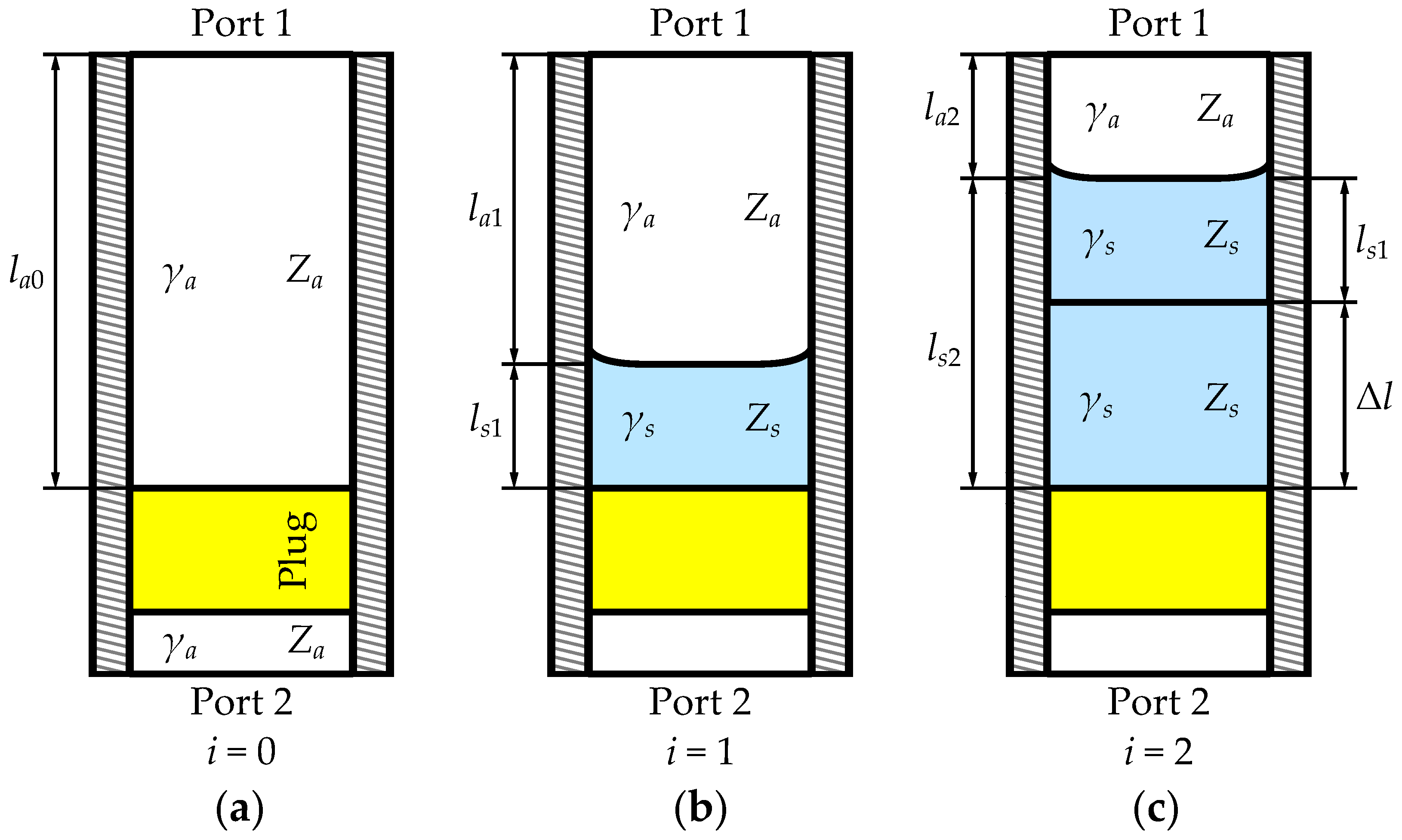
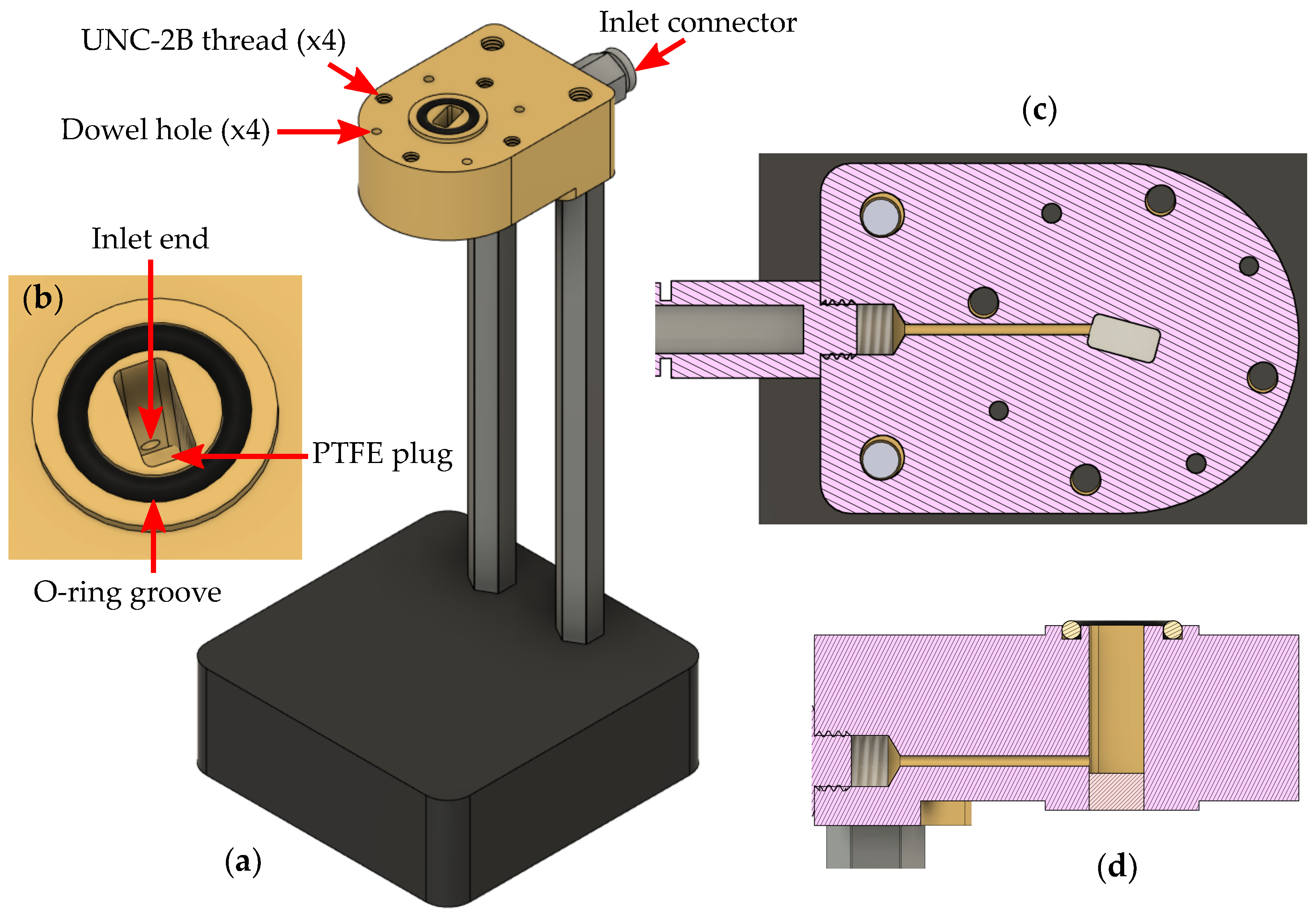
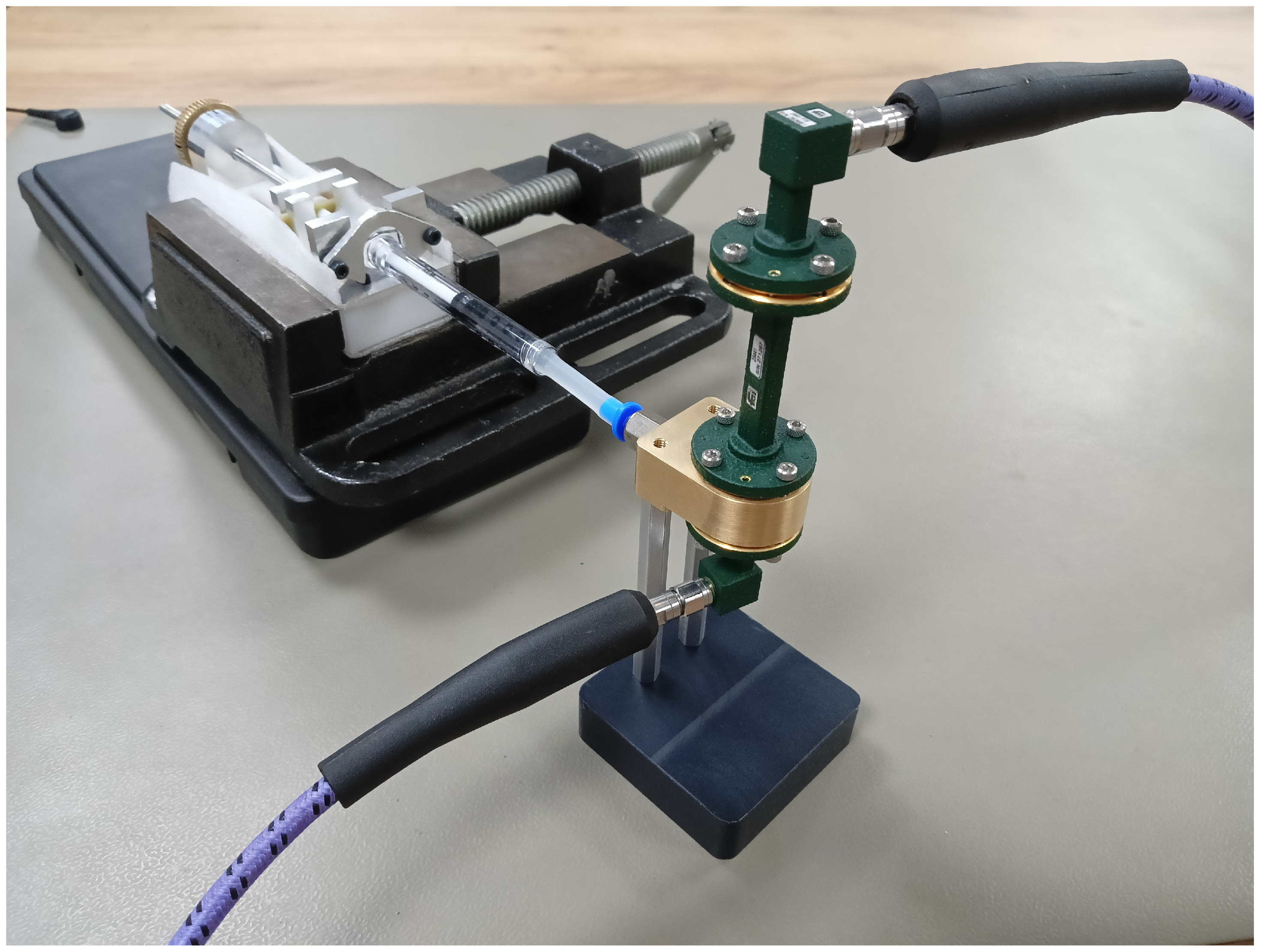
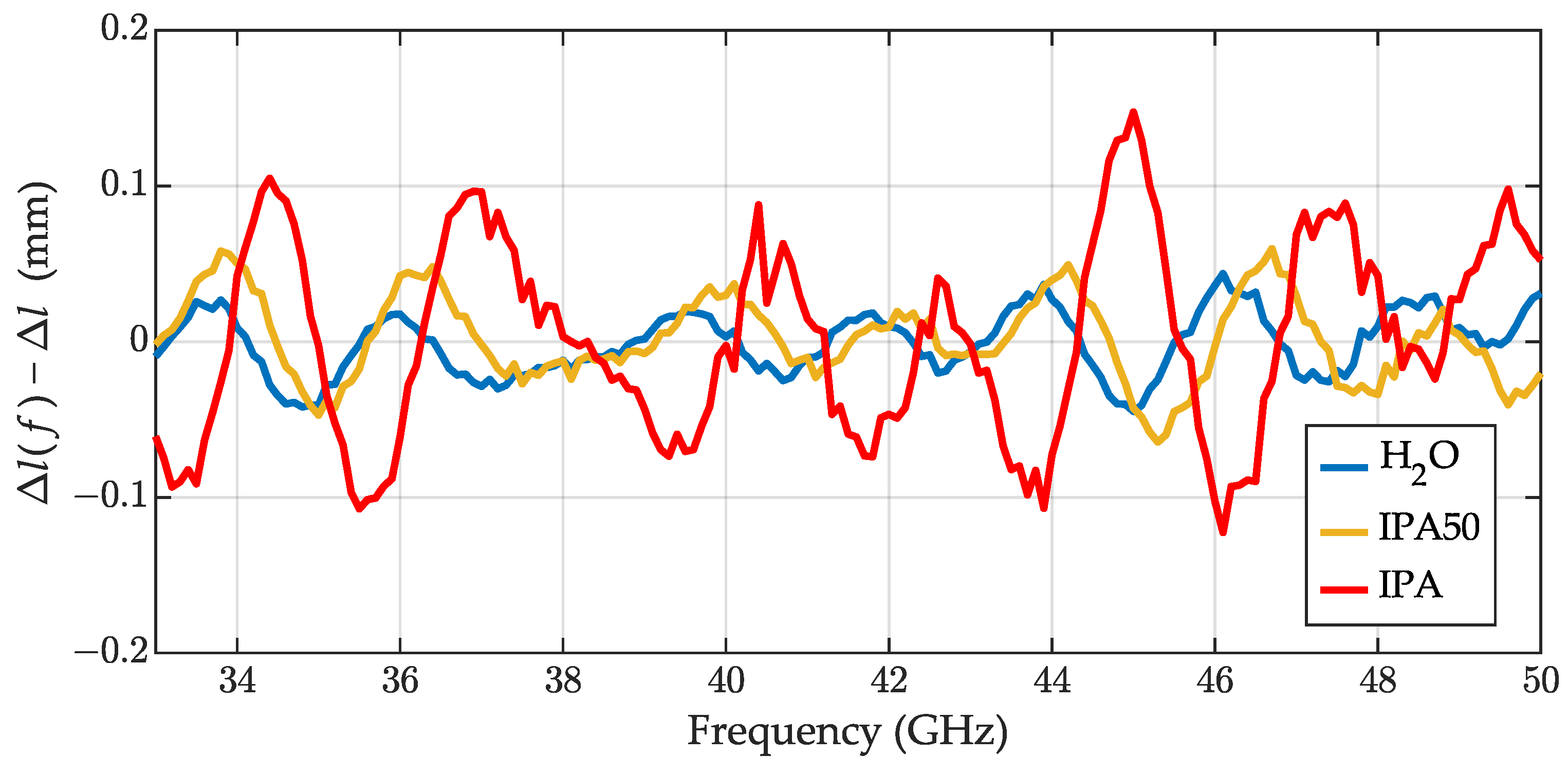
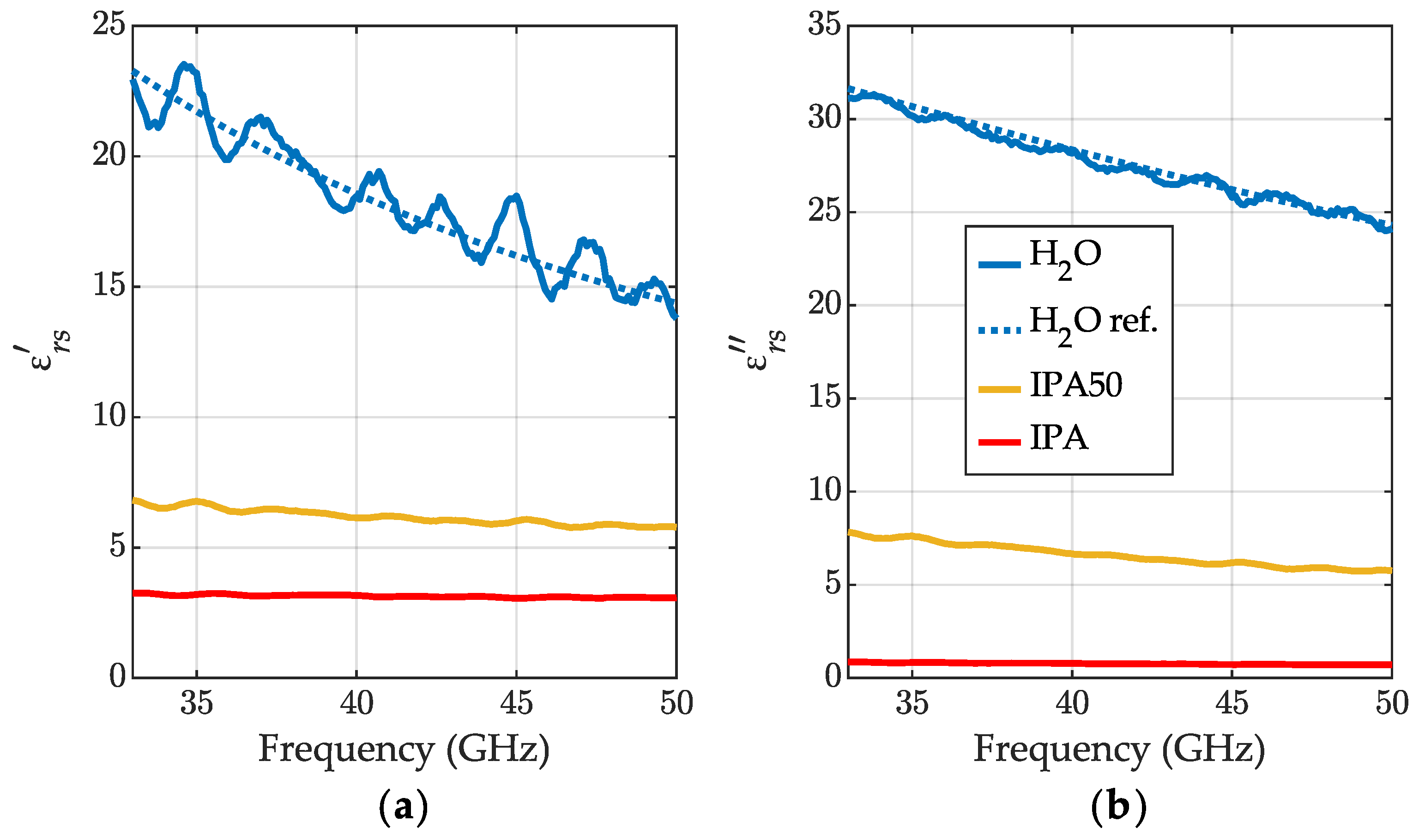
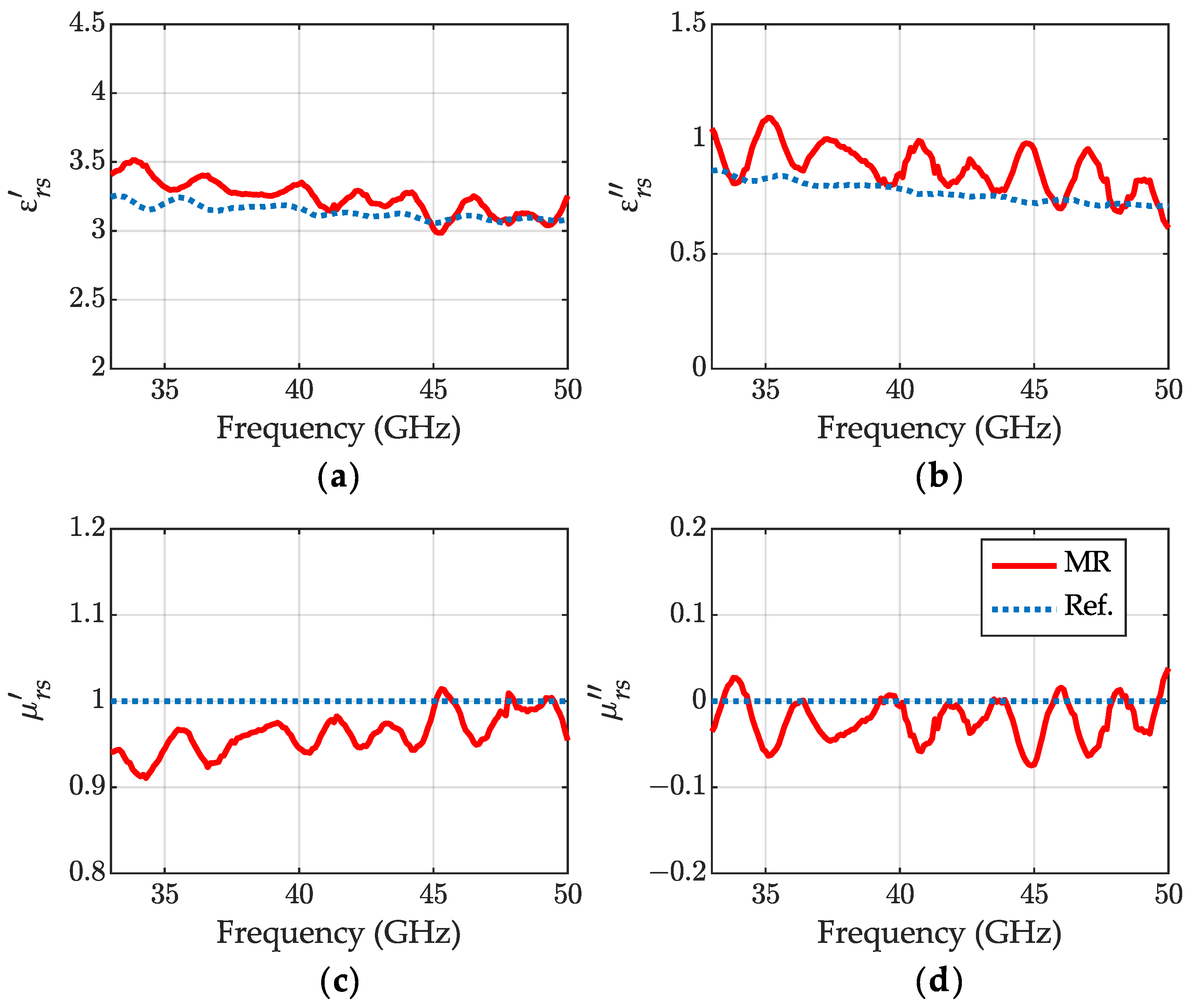
Disclaimer/Publisher’s Note: The statements, opinions and data contained in all publications are solely those of the individual author(s) and contributor(s) and not of MDPI and/or the editor(s). MDPI and/or the editor(s) disclaim responsibility for any injury to people or property resulting from any ideas, methods, instructions or products referred to in the content. |
© 2023 by the authors. Licensee MDPI, Basel, Switzerland. This article is an open access article distributed under the terms and conditions of the Creative Commons Attribution (CC BY) license (https://creativecommons.org/licenses/by/4.0/).
Share and Cite
Kalisiak, M.; Wiatr, W.; Papis, R. Applicability of the Meniscus-Removal Method for Q-Band Liquid Characterization in Semi-Open Waveguide Cell. Sensors 2023, 23, 5390. https://doi.org/10.3390/s23125390
Kalisiak M, Wiatr W, Papis R. Applicability of the Meniscus-Removal Method for Q-Band Liquid Characterization in Semi-Open Waveguide Cell. Sensors. 2023; 23(12):5390. https://doi.org/10.3390/s23125390
Chicago/Turabian StyleKalisiak, Michał, Wojciech Wiatr, and Radosław Papis. 2023. "Applicability of the Meniscus-Removal Method for Q-Band Liquid Characterization in Semi-Open Waveguide Cell" Sensors 23, no. 12: 5390. https://doi.org/10.3390/s23125390
APA StyleKalisiak, M., Wiatr, W., & Papis, R. (2023). Applicability of the Meniscus-Removal Method for Q-Band Liquid Characterization in Semi-Open Waveguide Cell. Sensors, 23(12), 5390. https://doi.org/10.3390/s23125390






